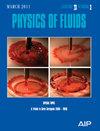2 马赫压缩-斜坡冲击/边界层相互作用下的非稳定表面压力场研究
IF 4.1
2区 工程技术
Q1 MECHANICS
引用次数: 0
摘要
使用带宽约为 10 kHz 的快速压敏涂料,研究了马赫数为 2 的气流中 20° 压缩斜坡诱发的冲击/边界层相互作用。平均分离流长度尺度约为两个上游边界层厚度,这表明相互作用是微弱的。主要分析包括交叉相关、相干和时域滤波。研究了两个不同的频段:低频(f < 2000 Hz; StL < 0.1)和中频(0.1 < StL < 0.26)。低频段时序和相干性显示,震脚运动主要与重新附着区域相关,这表明分离气泡的呼吸运动已经形成。据观测,呼吸运动发生在局部和全局(跨度平均)。此外,在低频段,上游边界层的波动与重新附着区的波动有一定的相关性,但与间歇区的波动没有相关性。在中频段,间歇区、分离气泡和再附着区都与上游边界层波动有显著相关性,其中上游波动处于领先地位。该频段的时间序列显示了广泛的压力波动区域,这些波动贯穿相互作用并影响整个相互作用。这种大尺度波动没有已知的湍流源,相信是风洞现象造成的。结论是,主要的低频呼吸运动遵循振荡器模型,但上游波动仍与主要呼吸运动无关,似乎遵循放大器模型。本文章由计算机程序翻译,如有差异,请以英文原文为准。
Investigation of the unsteady surface pressure field under a Mach 2 compression-ramp shock/boundary-layer interaction
The shock/boundary-layer interaction induced by a 20° compression ramp in a Mach 2 flow was investigated using fast pressure-sensitive paint with a bandwidth of about 10 kHz. The mean separated flow length-scale is about two upstream boundary layer thicknesses, which indicates the interaction is weak. The primary analysis consists of cross-correlations, coherence, and time-domain filtering. Two different frequency bands were investigated: low-frequency (f < 2000 Hz; StL < 0.1) and mid-frequency (0.1 < StL < 0.26). The low-frequency band time sequences and coherence reveal the shock-foot motion is mainly correlated with the reattachment region, which is indicative of the well-established breathing motion of the separation bubble. The breathing motion is observed to occur locally and globally (spanwise-averaged). Furthermore, in the low-frequency band, fluctuations in the upstream boundary layer are moderately correlated with the reattachment region fluctuations, but show no correlation with the intermittent region fluctuations. In the mid-frequency band, the intermittent region, separation bubble and reattachment region all exhibit significant correlation with the upstream boundary layer fluctuations, with the upstream fluctuations leading. The time-sequences in this frequency band reveal broad regions of pressure fluctuations that sweep through the interaction and affect the entire interaction. There is no known turbulent source for such large-scale fluctuations and they are believed to be due to a wind tunnel phenomenon. It is concluded that the dominant low-frequency breathing motion follows an oscillator model, but there remain significant correlations to upstream fluctuations that are not tied to the dominant breathing motion and seem to follow an amplifier model.
求助全文
通过发布文献求助,成功后即可免费获取论文全文。
去求助
来源期刊

Physics of Fluids
物理-力学
CiteScore
6.50
自引率
41.30%
发文量
2063
审稿时长
2.6 months
期刊介绍:
Physics of Fluids (PoF) is a preeminent journal devoted to publishing original theoretical, computational, and experimental contributions to the understanding of the dynamics of gases, liquids, and complex or multiphase fluids. Topics published in PoF are diverse and reflect the most important subjects in fluid dynamics, including, but not limited to:
-Acoustics
-Aerospace and aeronautical flow
-Astrophysical flow
-Biofluid mechanics
-Cavitation and cavitating flows
-Combustion flows
-Complex fluids
-Compressible flow
-Computational fluid dynamics
-Contact lines
-Continuum mechanics
-Convection
-Cryogenic flow
-Droplets
-Electrical and magnetic effects in fluid flow
-Foam, bubble, and film mechanics
-Flow control
-Flow instability and transition
-Flow orientation and anisotropy
-Flows with other transport phenomena
-Flows with complex boundary conditions
-Flow visualization
-Fluid mechanics
-Fluid physical properties
-Fluid–structure interactions
-Free surface flows
-Geophysical flow
-Interfacial flow
-Knudsen flow
-Laminar flow
-Liquid crystals
-Mathematics of fluids
-Micro- and nanofluid mechanics
-Mixing
-Molecular theory
-Nanofluidics
-Particulate, multiphase, and granular flow
-Processing flows
-Relativistic fluid mechanics
-Rotating flows
-Shock wave phenomena
-Soft matter
-Stratified flows
-Supercritical fluids
-Superfluidity
-Thermodynamics of flow systems
-Transonic flow
-Turbulent flow
-Viscous and non-Newtonian flow
-Viscoelasticity
-Vortex dynamics
-Waves
 求助内容:
求助内容: 应助结果提醒方式:
应助结果提醒方式:


